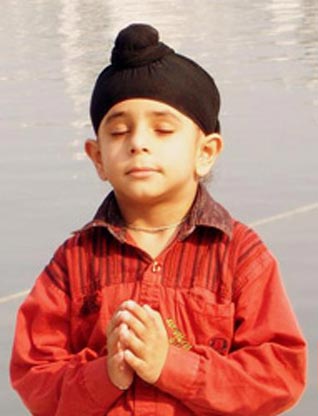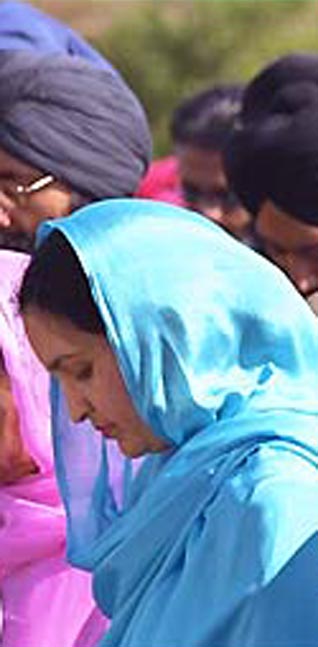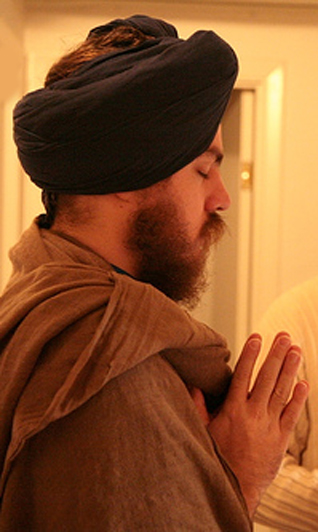Sikhing Answers
Who is Bhagauti?
Sikhing Answers - VI
This is the SIXTH in our series of questions and answers where we seek your active participation.
A question is posed to you, our readers, inviting you to provide your answers.
That is, each one of you - young and old - is invited to share with us
what YOU believe is the correct answer. There is no presumption of a
right or wrong answer, and nothing is sacrosanct - that is, please feel
free to tell us what you honestly think, believe or conjecture.
Each question will remain open for answers for ONE WEEK at the end of
which, we’ll close the question, and have a moderator review all the
answers, do some research as well, and collate it all in order to come
up with a concise and definitive answer.
Once the moderator formulates the “final answer”, it’ll be posted, and
all the answers provided to date to that particular question will be
deleted.
This is not an academic exercise. Sikhi being a layperson’s religion, we
encourage all to provide what they know through their personal
knowledge and research.
All we ask is that:
1 you steer away from academic or esoteric lingo
2 not regurgitate what you unearth on google, wikipedia, etc.
3 be very short, and to the point
We’ll fine tune this process as we go along and, before long, hope to
have several questions on the table at the same time, with their closing
dates staggered so as to allow you to concentrate on one question at a
time.
The answers will to be posted at the bottom of each question page, where space has been provided for “Comments”.
We suggest that you encourage each of your children to participate separately, as can each adult in a family or household.
Thus, we will teach each other.
TODAY'S QUESTION - # 6
The daily Sikh prayer - the ardaas - begins with a series of invocations, and the very first one is to "Bhagauti".
"pritham bhagauti simar kay ..." are the very opening words.
Literally meaning: "First and foremost, we medidate on Bhagauti ... !"
Who or what is "Bhagauti" and why does it precede the Gurus in the ardaas?
Posted on February 17, 2012
Closing Date: February 25, 2012
Conversation about this article
1: Anita Kaur (India), February 17, 2012, 7:28 AM.
Bhagauti is the Supreme One to whom we pray first and foremost for being the Creator of every thing every where and every one!
2: Rajvin Singh (Malaysia), February 17, 2012, 8:07 AM.
I agree with Anita Kaur. God is always first, even before our Gurus and anything else.
3: Maninder Singh Dhiman (Patiala, Punjab), February 17, 2012, 8:20 AM.
I am looking for a video that teaches us how to take "Hukam" from Guru Granth Sahib properly. There are many like me who need such guidance.
4: Sandeep Singh Brar (Canada), February 17, 2012, 9:37 AM.
In the opening lines of the Ardaas, Guru Gobind Singh - who composed them - asks Sikhs to remember the Supreme Being and the Gurus. In referring to Waheguru, Guru Gobind Singh chose to use the unique metaphor of the sword (Bhagauti). The word Bhagauti, literally 'sword', has been misinterpreted by some to suggest that it is a reference to a Hindu deity with a similar sounding name and that these lines are evidence that Sikhs are worshipers of this Hindu deity. This is not the case as the Sikh context of the word has an altogether different meaning. The following lines from the poetry of Bhai Gurdas, the original scribe of the Guru Granth Sahib, help to clarify the Sikh definition of Bhagauti as a sword: "nau bhagauti lohu gharaia" - translation: "Iron (a lowly metal), when properly wrought, becomes a (powerful) sword." Bhai Gurdas, Vaaran XXV:6.
5: Mahanjot Singh (Mississauga, Ontario, Canada), February 17, 2012, 12:20 PM.
In the context of our daily ardaas, 'Sri Bhagauti' literally means the 'Mighty Sword'. The recitation of ardas commences with the opening stanza of the "Vaar Sri Bhagauti ji" written by Guru Gobind Singh. The said Vaar is in the Dasam Granth. There are a number of compilations therein, each clearly and unequicocally referring to the sword as Bhagauti. The reference has nothing to do with any Hindu god or goddess - Durga, Shakti, or anyone else - even though Hindus too use the term, but in other connotations. The reference to the sword at the beginning of the ardaas relates to the fact that the sword - in Sikh parlance - is symbolic of Waheguru.
6: Baldev Singh (Bradford, United Kingdom), February 17, 2012, 4:22 PM.
Guru Gobind singh tells us clearly that the 'Sword' - symbolic of Waheguru - is our Saviour, as opposed to any petty devi or devta. It is a symbolism often used in other faiths as well, including Christianity, Islam and Judaism.
7: J. Kaur (Richboro, PA, U.S.A.), February 17, 2012, 5:55 PM.
I agree with Sandeep Singh Brar. I have always believed in my mind that Bhagauti is the power of iron/steel. I believe that Guru Gobind Singh believed that sword is like a surgeon's steel that cuts the wound of society and is like an anchor or protector.
8: GurYaad Singh (Canada), February 17, 2012, 8:00 PM.
Bhag= deep inside, auti =power (shakti). And deep inside (deepest) is the place of God, like Bhagwan (wan=maalik). Pritham Bhagauti - Pritham=one, Bhagauti = power from deep inside, from Him.
9: Gurinder singh (Stockton, California, U.S.A.), February 17, 2012, 10:57 PM.
Sandeep Singh ji has expressed it well. Many other writings of the Dasam Granth start with "Ik Oankar Sri Waheguru ji ki Fateh", followed by "Sri Bhagauti ji Sahai". It is WaheGuru symbolized by the sword.
10: Paramjeet Singh (Kanpur, India), February 18, 2012, 8:40 AM.
I got to know a lot of precious meanings from all of your comments. Thanks.
11: Ravinder Singh (Mumbai, India), February 18, 2012, 9:34 AM.
Our shabad Guru addresses Ik Oankar by different names. Guru Gobind Singh, in his Jaap Sahib, Chaupai, and Sawaiyyas, teaches us the worship of one God. So "Sri Bhaugati" can mean no one except the One God. Also, we take the names of the Gurus because they are one with God. There is nothing to differentiate between God and the Nanaks. In the Sikh way of life, except the worship of One God there is no place of worship of another. The true sant and brahmgyani have also been exalted in the Sukhmani Sahib because they have become one with the Maker.
12: Mohan Singh (Toronto, Ontario, Canada), February 18, 2012, 9:54 AM.
According to Darpan of Prof. Sahib Singh, the meaning of bhagauti is the true devotee of the One God. As per Mahan Kosh, Bhagwant is the One God, and bhagauti is His worshipper. In Guru Granth Sahib there are 9 shabads on Bhagauti, 3 by Guru Amar Das and 6 by Guru Arjan.
13: Gurinder Singh (Stockton, California, U.S.A.), February 18, 2012, 12:25 PM.
Guru Sahib, in retelling the mythical lore of Durga in Chandi di Vaar, paurri 53, uses the word "bhagauti" for 'sword': Durga held out her bhagauti (sword), appearing like great lustrous fire; She struck it on the king Sumbh and this lovely weapon drinks blood.
14: Kanwal Prakash Singh (Indianapolis, Indiana, U.S.A.), February 19, 2012, 9:52 AM.
Thank you for such scholarly and illuminating explanations of the word "Bhagauti." and for sikhchic.com's series on distinct words, phrases, and concepts in the Sikh faith, sacred literature and tradition. I agree with the scholarship and wisdom offered by your readers about Bhagauti. In Guru Gobind Singh's Chaupai there are several words that refer to God on whose banner is the symbol of the sword. The reference to God as Sword (Sri Sahib), or the one wielding/ carrying/ symbolizing the Sword is limited to the image of a weapon to wage a war. Most likely, the word Bhagauti is a singularly honorable tribute to God's countless attributes above all other excellences: That God is Pure and Immaculate; that God is Just; that God as Bhagauti (Kharag-ket) symbolizes and manifests Justice, Dignity, and Love for all that God (Waheguru: Wonderful Lord)) has created; that the entire unfathomable Creation is One God's play and that "God is the Father and Mother of all and we are all God's Children." Therefore, Bhagauti represents Immaculate Order and Peace; Dispenser of Equal Justice; that God Dispels all Darkness, for God is All Light; that God is the Destroyer of tyrants, unjust, those who bring tyranny and suffering upon others; for above all: God is Eternal Compassion (Meharvaan) and Protector of All Life and All Creation (Universal Dignity, Liberty, and Sacred Rights without distinction of status, culture, gender, or ethnicity) in its wonderful and myriad manifestations. As Pritham Bhagauti (Primal and Supreme God of Justice), God enforces Righteousness across His created Universe.
15: Balbir Singh (Germany), February 20, 2012, 2:58 PM.
Someone may please explain it. Bhagauti is mentioned three times in the ardaas. Also, it is mentioned before the Gurus themselves. Why?
16: Ajit Singh Batra (Pennsville, New Jersey, U.S.A..), February 20, 2012, 5:39 PM.
In my opinion, God is Bhagwant (Akal Purakh). The term 'bhagauti' is used for one who is a devotee of God and God alone. E.g., Sukhmani, Ashtpadi 9, Paurri 3: "bhagauti bhagwant bhagat ka rang".
17: Taranjeet Singh (Delhi, India), March 04, 2012, 11:55 AM.
The Supreme Being - Lord!
18: Ananda Gurudasa (Long Beach, California, USA), January 15, 2013, 9:41 AM.
In my undestanding Bhagauti is referring to Waheguru. He is the all encompassing Mother as well as Father of us all, not in a literal way, not in Guru Ji's "form", certainly not Chandi or Durga. Nonetheless, Guru Ji used both the feminine and masculine to describe Waheguru. Guru is both, and neither ... such is my limited understanding.
19: S P Sonak (Sangrur, Punjab), June 27, 2013, 1:28 AM.
Bhagauti is Waheguru ... may He be 'visulaized' in any form of power ... like the kirpan, for example.
20: Balwant Singh (New Delhi, India), August 27, 2013, 12:15 PM.
I have been so confused on this word (bhagauti). But when I read all the comments, I realize that God is One.
21: Wajinder Singh (Malaysia), May 09, 2014, 10:12 AM.
Many a name and reference to God in the Guru Granth Sahib is masculine. Gurbani grammar (viaakaran) confirms this - but this male gender is merely a grammatical limitation. While bhagauti is of the feminine gender -- the origins of the word goes back to the Hindu devi, durga. The Sikh Bhagauti, however, is a different entity altogether. It is mentioned once first, then thrice thereafter, before the names of the Ten Guru Sahibans. Damdami taxalis claim it refers to the sword. Sikhs worship neither a devi nor a sword. Sikhs are worshippers of the Timeless One. No other.
22: Kanwarbir (Chandigarh, Punjab), June 01, 2014, 1:35 AM.
Bhagauti is Nature, Energy, Power, Waheguru, or the representation of all of the above in the physical sword. I find the "... simar ke" to be most enlightening. An injunction to keep in mind the higher power ... rather than one's selfish ego.
23: Sanveer (England), March 25, 2015, 6:15 PM.
Sri Bhagauti ji is the kirpan / sword; the sword is a metaphor for Akal Purakh who is The Creator, the One God of all!





